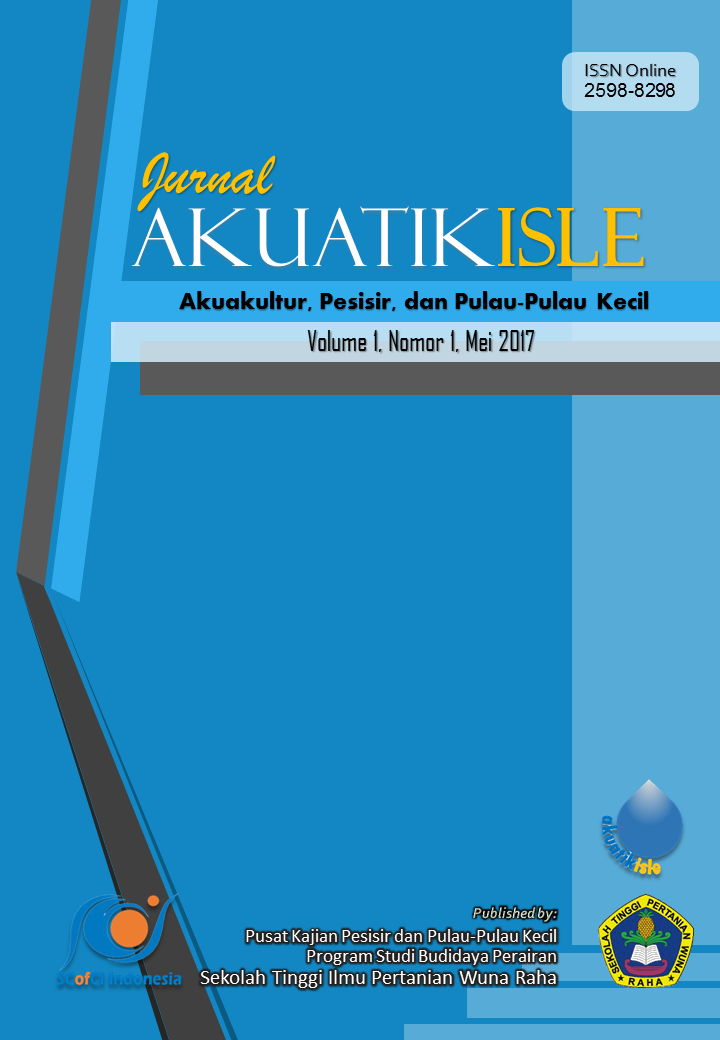Akuatikisle: Jurnal Akuakultur, Pesisir dan Pulau-Pulau Kecil
Full Length Article
Effect of fertilization and density on the survival rate and growth of post-larva of shrimp vaname (Litopenaues vannamei)
Pengaruh pemupukan dan padat penebaran terhadap tingkat kelangsungan hidup dan pertumbuhan post larva udang vaname (Litopenaues vannamei)
Highlights
Generate NLP AI by Wizdam ID.
Abstract
The aim of this research is to know the effect of fertilization and density on survival rate and the absolute growth of post-larvae of shrimp vanname (Litopenaeus vannamei). The study was conducted from 18 August to 5 September 2013 at Oensuli ponds, Kabangka, Muna Regency, Indonesia. The research used animal test of vaname shrimp stadium PL6, a fertilizer of Urea and TSP. The study used styrofoam container, 75 cm long, 37 cm wide, and 27 cm high. Research using Factorial RAL, fertilization and density used three levels, three replications, so that the experiment of 27 units. The fertilizer treatment consisted of no-fertilizer (Control), combination Urea 0.5 g/TSP 0.7 g (P2), combination Urea 0.7 g/TSP 0.9 g (P3). The density treatment consists of density 9 ind/container (Control), density 14 ind/container (KP2) and density 19 ind/container (KP3). Parameters observed survival rate (SR) and absolute growth (G). Data analysis using ANOVA (a0,05) with IBM SPSS Statistic 22. The results showed that fertilization and stocking density had a significant effect on survival and post larvae growth of vaname shrimp. The optimum use of 0.7 g/TSP 0.9 g urea per container. The optimum fertilizer composition of growth was Urea 0.5 g/TSP 0.7 g per container. The best survival rate through a combination of Urea 0.7 g/TSP 0.9 g, density 9 ind per container, equivalent Urea 26 kg/TSP 33 kg density 333.000 ind per ha. The best growth through a combination of Urea 0.5 g/TSP 0.7 g, density 9 ind per container or Urea 19 kg/TSP 26 kg, density 333.000 ind per ha.
Abstract
Penelitian bertujuan untuk mengetahui pengaruh pemupukan dan kepadatan terhadap tingkat kelangsungan hidup dan pertumbuhan mutlak post-larva udang vanname (Litopenaeus vannamei). Penelitian dilaksanakan 18 Agustus sampai 5 September 2013 di pertambakan Oensuli, Kecamatan Kabangka, Kabupaten Muna. Penelitian menggunakan hewan uji udang vaname stadia PL6, pupuk Urea dan TSP. Penelitian menggunakan wadah styrofoam, panjang 75 cm, lebar 37 cm, dan tinggi 27 cm. Penelitian menggunakan RAL Faktorial, yakni pemupukan dan kepadatan tiga taraf, tiga ulangan, sehingga percobaan sebanyak 27 unit. Perlakuan pemupukan terdiri atas tanpa pupuk (Kontrol), kombinasi Urea 0,5 g/TSP 0,7 g (P2), kombinasi Urea 0,7 g/TSP 0,9 g (P3). Perlakuan kepadatan terdiri atas kepadatan 9 ind/wadah (kontrol), kepadatan 14 ind/wadah (KP2) dan kepadatan 19 ind/wadah (KP3). Parameter yang diamati tingkat kelangsungan hidup (SR) dan pertumbuhan mutlak (G). Analisis data menggunakan ANOVA (a0,05) dengan IBM SPSS Statistik 22. Hasil analisis menunjukkan pemupukan dan kepadatan tebar berpengaruh sangat nyata terhadap kelangsungan hidup dan pertumbuhan post larva udang vaname. Penggunaan pupuk optimum terhadap tingkat kelangsungan hidup adalah kombinasi Urea 0,7 g/TSP 0,9 g per wadah. Komposisi pupuk optimum terhadap pertumbuhan adalah Urea 0,5 g/TSP 0,7 g per wadah. Tingkat kelangsungan hidup terbaik melalui kombinasi Urea 0.7 g/TSP 0.9 g, kepadatan 9 ind per wadah, setara Urea 26 kg/TSP 33 kg kepadatan 333.000 ind per ha. Pertumbuhan terbaik melalui kombinasi Urea 0,5 g/TSP 0.7 g, kepadatan 9 ind per wadah atau Urea 19 kg/TSP 26 kg, kepadatan 333.000 ind per ha.
Keywords
Introduction
Section snippets
Material and Methods
Materials and methods from the full-text PDF of this article cannot be displayed.
Results
Results from the full-text PDF of this article cannot be displayed.
Discussion
Discussion from the full-text PDF of this article cannot be displayed.
Conclusions
Conclusions from the full-text PDF of this article cannot be displayed.
Acknowledgment
Acknowledgment from the full-text PDF of this article cannot be displayed.
Funding Information
Program Studi Budidaya Perairan, Sekolah Tinggi Ilmu Pertanian Wuna Raha
Competing interest
The authors declare that they have no known competing financial interests or personal relationships that could have appeared to influence the work reported in this paper.
Conflict of interest
The authors declare that the research was conducted in the absence of any commercial or financial relationships that could be construed as a potential conflict of interest.
Ethical approval acknowledgements
No ethical approval required for this article. All procedures followed were in accordance with the ethical standards of the responsible committee on human experimentation (institutional and national) and with the Helsinki Declaration of 1975, as revised in 2008 (5)
Supplementary files
Data sharing not applicable to this article as no datasets were generated or analysed during the current study, and/or contains supplementary material, which is available to authorized users.
Bibliographic Information
Cite this article as:
-
Submitted
1 March 2017 -
Revised
3 April 2017 -
Accepted
27 April 2017 -
Published
27 May 2017 -
Version of record
30 May 2017 -
Issue date
31 May 2017
-
Academic subject
Akuakultur
Copyright
One of the factors that affect the growth of tiger shrimp is the quality of feed. Nutrient content in feed such as protein, carbohydrate and fat, generally used as a parameter of feed quality. Feed consumed by shrimp is not all digested, one of which depends on the enzymatic ability of the shrimp digestive tract. The use of probiotic bacteria in addition to having the ability to reduce colonies, inhibit the growth of pathogenic bacteria, and neutralize water quality, probiotic bacteria can help digestibility of the intestine.
See Usman & Rochmady.
Copyright © 2017 Ernawati & Rochmady. Sangia Research Media and Publishing. Production and hosting by Sangia (SRM™).  This work is licensed under a Creative Commons Attribution-ShareAlike 4.0 International License.
This work is licensed under a Creative Commons Attribution-ShareAlike 4.0 International License.
Disclaimer: All claims expressed in this article are solely those of the authors and do not necessarily represent those of their affiliated organizations, or those of the publisher, the editors and the reviewers. Any product that may be evaluated in this article or claim that may be made by its manufacturer is not guaranteed or endorsed by the publisher.



